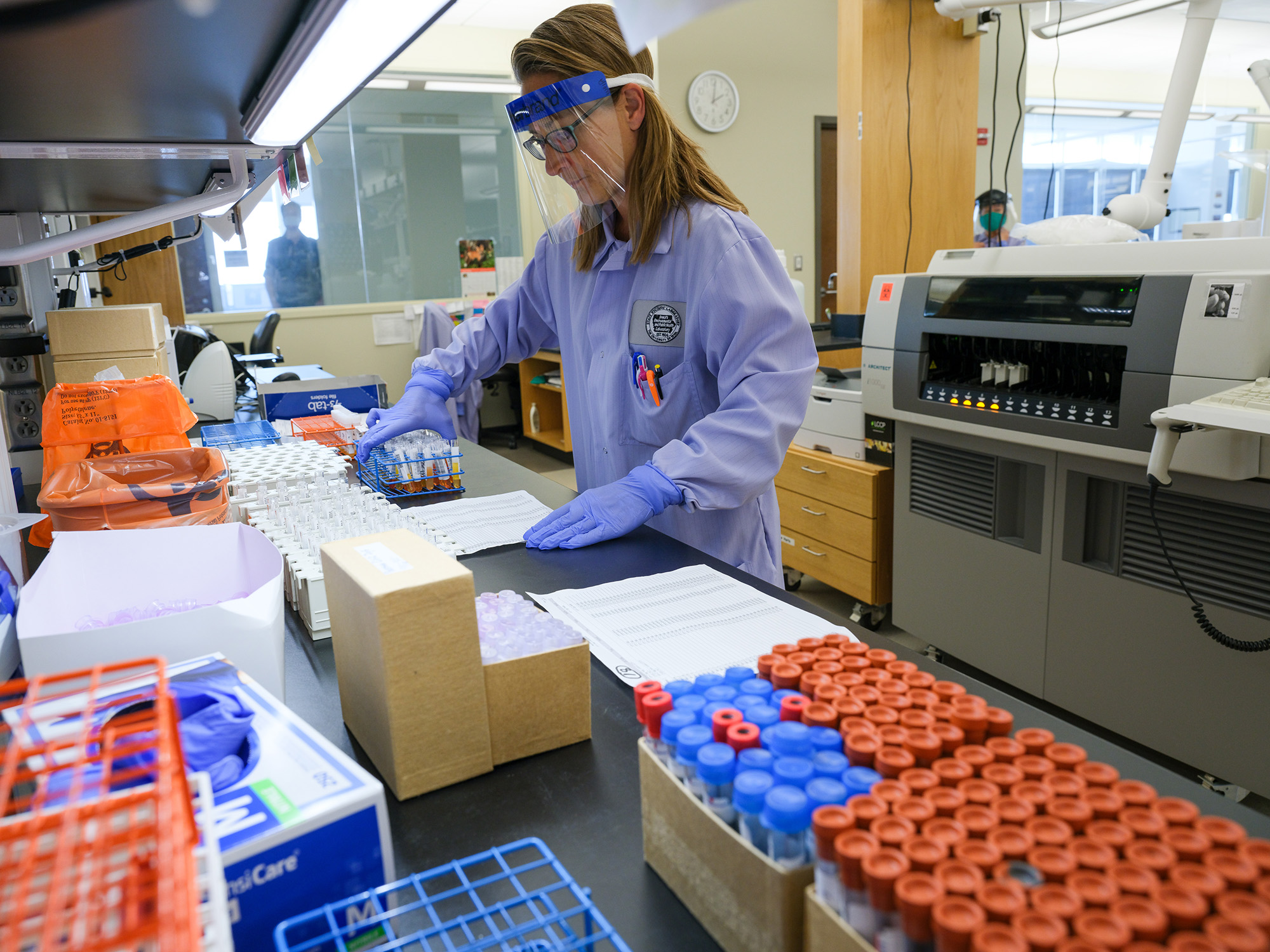Iowa’s landmark moments from the pandemic

On March 8, 2020, the State Hygienic Laboratory at the University of Iowa had its first positive test result for COVID-19. In the year that followed, the UI was at the forefront of COVID-19 research, treatments, patient care, and vaccination. Here’s a look back at moments from the past year that exemplify our expertise and Hawkeye spirit.
At one year: Congratulations, thank you, and keep looking ahead
A full year has passed since the University of Iowa began its response to the COVID-19 pandemic. On March 17, 2020, we directed all employees outside of UI Health Care to work remotely unless their critical function required them to be on campus. We had already announced we would move all classes online for the rest of the semester, and we had already started to bring home those who were studying, researching, and teaching abroad. During this incredible year, our university community has demonstrated remarkable patience, resilience, cooperation, and mutual support. We have learned how to deal with this global pandemic while continuing to fulfill our mission as best we can.
I thank each and every one of you for your dedication and your willing efforts—which I know have not always been easy—to make sure we remained the university the people of Iowa deserve and expect. I give special thanks to our frontline workers who have had to remain on campus. You have often put yourselves at greater risk and have had less opportunity to take time off from your duties, and you deserve our deepest gratitude.
My pride in the Hawkeye spirit has only been strengthened by how far we have come since last March. Our health care faculty and staff have been on the front lines of COVID treatments and vaccine development—often performing at lightning speed—while still meeting the other medical needs of our patients and communities. The State Hygienic Lab stepped up very quickly to meet the sudden demand for mass COVID testing. Our facilities, human resources, and technology teams have developed new ways to do our work and manage our infrastructure. Our faculty and staff quickly developed online teaching methods and platforms. Our research and creative enterprises have proceeded carefully but robustly, and they continue to produce extraordinary new knowledge, inventions, and literary and artistic works.
With more and more of us being vaccinated every day, optimism abounds that we will regather in our workplaces sooner rather than later. We are looking forward to turning all the lights on again in our classrooms, labs, studios, offices, and performance halls. Our frontline workers will enjoy a breather as those who have worked remotely return to campus. Yet we still have much work to do to end the pandemic and to keep our campus safe, and we must remain patient. There is much about this past year that we will all be glad to leave behind, but we will also carry forward what we have learned. Hawkeyes have always applied new knowledge, even from adverse circumstances, to teach, learn, research, create, engage with the public, and support our university community better than ever—and to do it together. That’s the University of Iowa I know, and that’s the University of Iowa I know we will always be.
Thank you again for all you have done this past year, and thank you for your continued efforts to ensure a better future for all—all of us on campus and all we serve throughout the state, nation, and world.
Bruce Harreld
President
Update: International travel
The Board of Regents lifted its 30-day ban on university-sponsored international travel for all faculty, staff, and students on March 11. The university will follow these procedures for international travel moving forward:
- Students: International travel is currently limited due to the coronavirus pandemic. Undergraduate student travel for University of Iowa purposes will not be approved through Aug. 1. Nonessential international travel for university purposes should be avoided to reduce the risk of contracting or spreading the virus. The university will continue to monitor travel risks and modify guidelines if and when conditions improve. Graduate and professional students may submit a high-risk travel proposal to International Programs for consideration.
- Faculty and staff: President Harreld may authorize individual faculty and staff international travel for departures if that travel is specifically tied to university responsibilities. Additional information on this process can be found in the travel section of the Coronavirus FAQ page. Faculty and staff inquiries regarding international travel can be directed to safety-abroad@uiowa.edu.
For more details, see the travel page of the UI Coronavirus website.
Campus operations
The university continues to monitor self-reported COVID-19 testing data on campus, while also tracking state, region, and national COVID-19 infection rates.
University of Iowa self-reported COVID-19 testing
These data reflect new cases since March 15, 2021.
The University of Iowa has published an updated snapshot of self-reported positive COVID-19 tests from faculty, staff, and students.
Number of self-reported cases of COVID-19:
Students
- New cases: 4
- Total cases: 3,037
Employees
- New cases: 1
- Total cases: 451
These numbers reflect only self-reported positive or presumed positive COVID-19 tests from UI faculty, staff, and students on the academic campus since Aug. 18, 2020. These data will not match data reported by UI Hospitals & Clinics or by the Iowa Department of Public Health for several reasons, including different testing time intervals and geographic scope. Students who also are employees of the university are only reported in the student number to avoid double counting. The UI has more than 30,000 students and nearly 30,000 employees. Many employees continue to work remotely but have self-reported to authorize sick leave.
Number of residence hall students in quarantine: 0*
Number of residence hall students in self-isolation: 4**
*Quarantine: Quarantine is used to keep someone who might have been exposed to COVID-19 away from others.
**Self-isolation: Isolation is used to separate people infected.